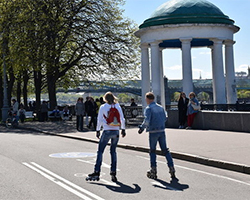Designing cities for health: how to change urban environments for the better?

WHO
Living in cities has been linked to higher exposure to pollution, lack of physical exercise, and a resulting increase in noncommunicable diseases. However, innovations in urban design can reverse this trend and show how cities can make people’s health better. Experts gathered at the WHO Urban Design for Health online symposium 14–16 April to share success stories that are already having an impact across the WHO European Region.
More people, more cars, more pollution
"For decades our city has been getting more crowded," says Erlijn Mulder, a strategic advisor for the city of Utrecht, Netherlands, which has been at the forefront of urban design for health. "There are more people, more cars, more pollution, more heat. How do we cope?”
He explains that they have learned to cope gradually by working in partnerships with companies, authorities and the people of Utrecht. “By investing in greening and public transport, we have attracted investors and companies to Utrecht. The city benefits in all sorts of ways, including economically as well as in terms of health and creating livability.”
WHO offers guiding principles designed to promote physically active lifestyles through transforming public spaces.
Active lifestyle: the best choice for city living
Physical inactivity accounts for an increasing proportion of deaths and disability across the Region. It is also associated with high health-care costs and lost productivity. Regular physical activity, on the other hand, is a safeguard against a range of chronic diseases, such as type 2 diabetes, cardiovascular diseases and some cancers. It is also a key determinant of weight control.
Combating this is as much about creating an active environment as it is about encouraging an active lifestyle, and urban design plays a key role. Lucy Saunders, founder of Healthy Streets, a consultancy based in London that works with cities worldwide, points to evidence that people who are active day in and day out throughout their lives are not necessarily the same people who have access to a lot of sporting facilities or are particularly enthusiastic about sports.
"There has been a recognition for a very long time that physical activity is important," she explains, “and there has been a lot of focus on promoting sporting activity, whereas actually, the people who are active throughout their lives are often those who don’t have a choice but to be active because it's built into their daily routine.” Cities also often have competing objectives, such as how to make themselves more attractive to investors or how to address urban poverty, which do not always naturally fit with creating an active city environment.
Benefits of car-free environments
The WHO symposium on Urban Design for Health will focus on producing win-win situations to help make cities become more conducive to physical activity while simultaneously achieving other politically important objectives.
In Utrecht, reducing car journeys has had a positive impact on businesses. "In the early 1990s we closed the old city centre for parking cars. That caused a huge protest among shopkeepers," says Mulder. "30 years later, things have changed. Now we say a city centre is an open, living exhibition. Cars are not attractive to have in your city streets. If you are cycling, it’s a slower journey and you see a lot more. If you see a bouquet of flowers or a farmers' market, it’s so much easier to stop and buy, and stay for a cup of coffee.”
Other initiatives have included a planned housing area close to the city center that is virtually unreachable by car due to congestion. Making this area car-owner free – relying on car-sharing and public transport – has both solved the transport problem by catering to bikes and pedestrians and is set to make the area a better and cleaner place to live.
Involving citizens for simple solutions
Different cities have different challenges, but Mulder encourages turning the city into a lab for all stakeholders to experiment with. "As a government you must keep everyone involved and ask questions, not just impose solutions,” he adds. "We now have 300 bus stops with bee-friendly flower gardens on the roofs, simply because of an idea that one of our partners came up with. And other cities are asking how they can do it too.”
The best solutions can also be the simplest. "Reducing the speed limit from 30 miles per hour to 20 on London streets has probably had the biggest impact," says Saunders. "This makes people cycling on those streets feel safe. We're animals, we respond to our sensory environment, and many of us won't cycle if it's noisy or scary.”
The 3-day symposium hosted by the WHO European Office for the Prevention and Control of Noncommunicable Diseases in partnership with Gehl, a design consultancy, is not a traditional conference, but a new type of learning event to advance action in this area.
Experts and stakeholders will share advice and inspiration, as well as practical examples and tools to develop action plans and innovative approaches to promoting physical activity and healthy living.



